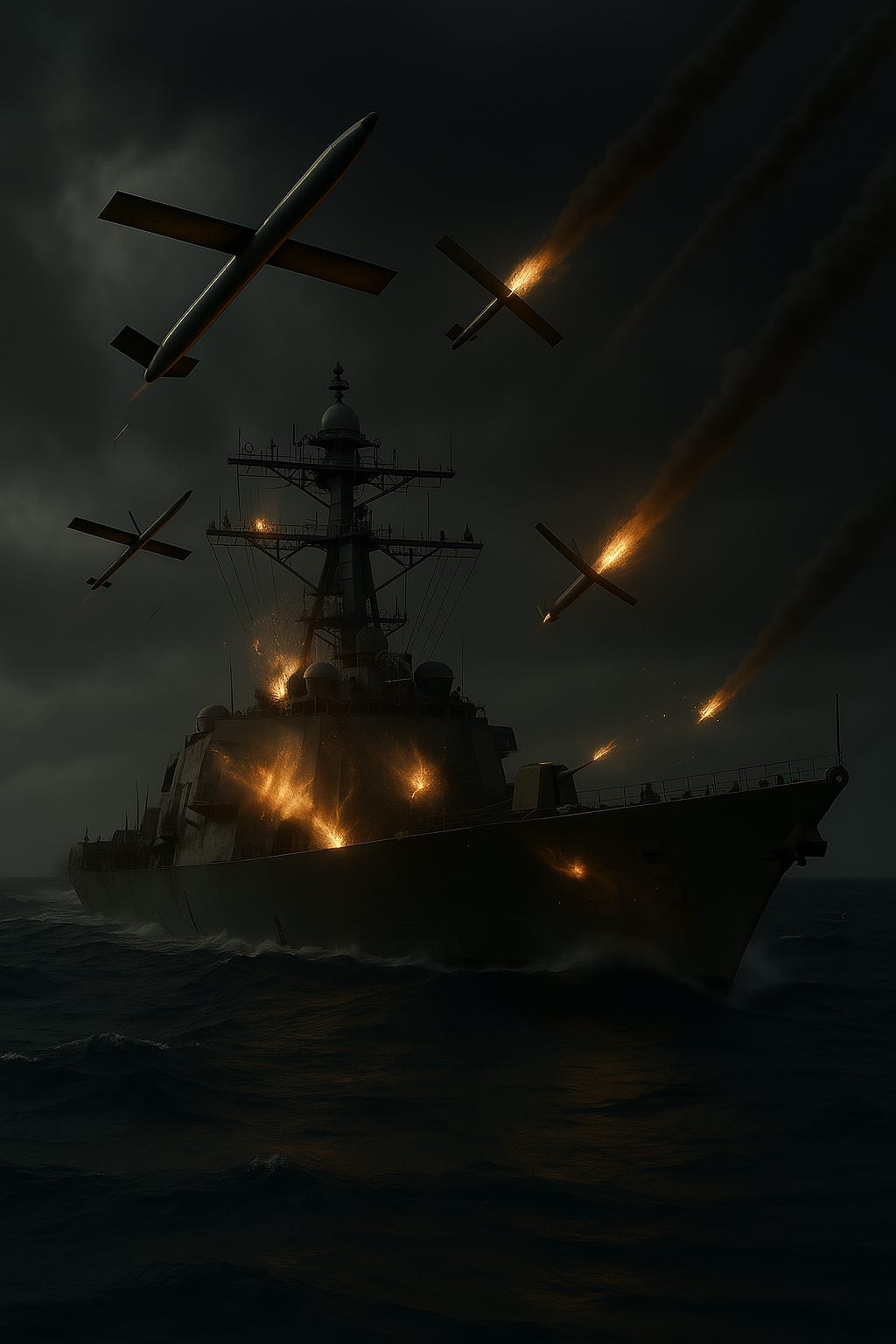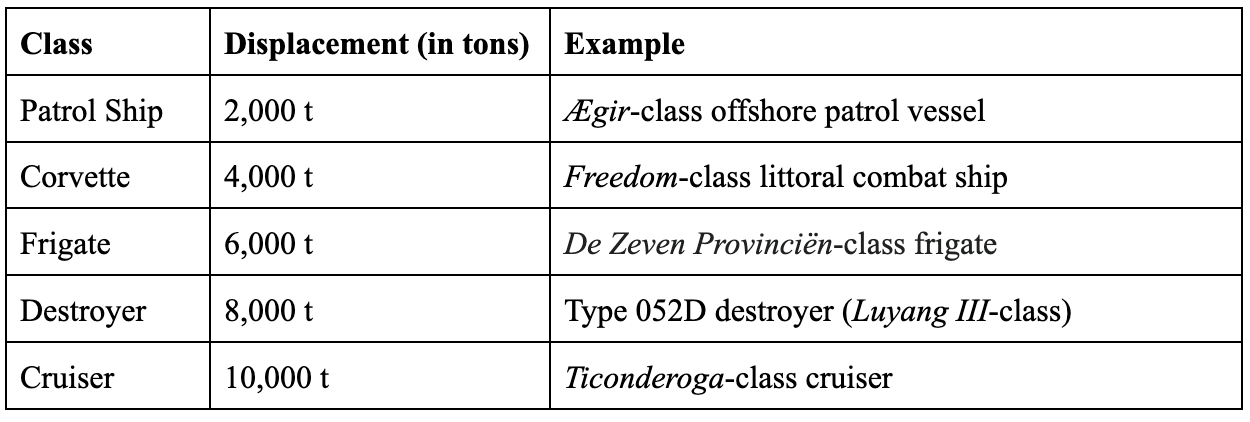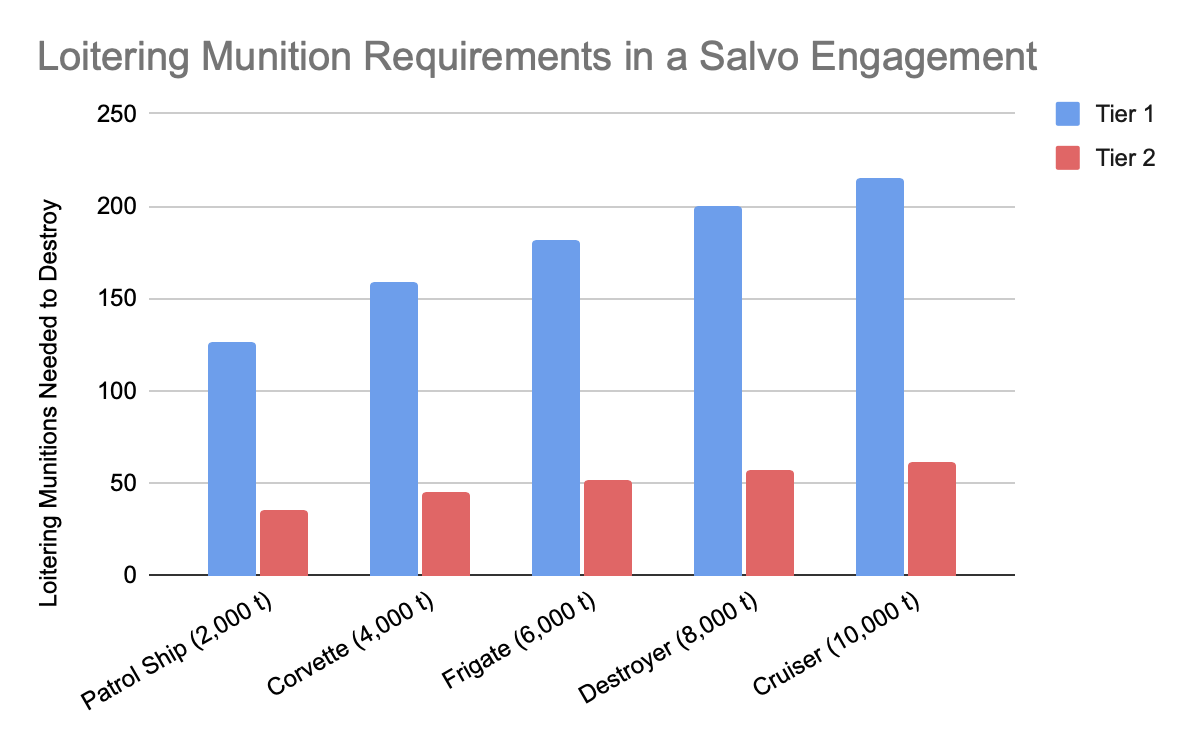Precision Mass at Sea: A Preliminary Analysis
Loitering munitions have transformed the character of land warfare in Nagorno-Karabakh, Ukraine, Gaza, and Syria, allowing military forces to carry out precision attacks in large numbers and at lower costs than those offered by traditional missiles and aircraft. However, the cost benefits of loitering munitions at sea, and how they differ from those on land, have not been fully explored. While the Houthis have made use of loitering munitions during the Red Sea Crisis, they have also employed anti-ship missiles and reusable drones such as the Samad family of systems, which fire their ordnance rather than crashing into targets and detonating as loitering munitions do. In fact, the two instances where the Houthis actually successfully sank a commercial ship occurred due to their use of either anti-ship missiles or unmanned surface vehicles, not loitering munitions. The jury is still very much out on what capabilities loitering munitions offer to naval forces. This article aims to begin such a discussion. It concludes that the most cost-effective use of loitering munitions in naval combat lies in their ability to overwhelm an opposing ship's air defenses, allowing traditional anti-ship missiles to break through and actually destroy the vessel. The main takeaway for Navy leaders should be the urgent need to field attritable, low-cost loitering munitions that can operate alongside anti-ship missiles as part of a strike salvo.
Capabilities and Costs
Like all weapons, loitering munitions come in a variety of different sizes and configurations, with immense cost differences between them. For our analysis, we will examine two different loitering munition "tiers." These are definitions created specifically for this article, primarily categorizing loitering munitions by warhead weight, which will be important to our analysis. This will allow for better ease of reference than the U.S. military's Group 1 through 5 UAS categories, which include maximum takeoff weight in their definitions, but do not account purely for payload. Most loitering munitions fit into the DoD's Group 1 and 2 definitions, with a few, such as the Shahed-136, bleeding into the characteristics of Group 3 UAS systems.
For our analysis, Tier 1 loitering munitions encompass small systems that carry fairly light warheads, usually weighing less than 10 pounds, and in land combat are generally found at the squad and platoon levels. Tier 2 loitering munitions are larger systems that carry heavier warheads weighing between 30 and 40 pounds that are often used for higher-level operational engagements, such as strikes on critical infrastructure. There are, of course, loitering munitions that carry even heavier warheads such as the Israeli Delilah, which are not discussed as part of this analysis since their capabilities bleed closer into the domain of cruise missiles.
The chart below categorizes the two tiers that will be examined in this article. The cost was calculated by taking the average, rounded to the nearest thousand, between the estimated costs of the three different systems listed in each of the example columns. While not perfect, these estimates provide us with baseline costs of the correct order of magnitude to conduct preliminary analysis
Both Tier 1 and Tier 2 loitering munitions cost significantly less than virtually all missiles employed by modern ground forces. Most anti-tank weapons cost anywhere between 1 and 200,000 USD (e.g. the American BGM-71 TOW and FGM-148 Javelin cost $218,000 and $351,000 respectively), while rocket artillery and tactical ballistic missiles such as the Guided Multiple Launch Rocket System (GMLRS) and Army Tactical Missile System (ATACMS) can cost in the hundreds of thousands to over 1 million dollars. Significant amounts are therefore saved through the use of loitering munitions when they are able to supplement traditional missiles and rockets. The question then is whether the same cost-effectiveness can be replicated at sea.
Naval Strike Salvos and Loitering Munitions
Modern naval combat fundamentally revolves around salvo fire. This has important implications for the role that loitering munitions will play in maritime conflicts. Loitering munitions offer the ability to mass fires at lower costs than most anti-ship missiles. However, the sheer volume needed to actually take warships out of action generally makes the cost benefits of the use of these systems lower than they are on land. We can illustrate this using the "cube root rule" which holds that the number of thousand-pound bomb equivalents needed to catastrophically kill a warship is equal to the cube root of 1/1000th of the ship's displacement in tons. For example, if a ship displaces 5,000 tons, roughly 1.7 1,000-pound bombs, or 1,700 pounds of ordnance, would be needed to take the ship out of action.
The chart and table below show the number of loitering munitions in both tiers that would be needed to destroy five different warships given their displacements. These displacements are meant to broadly reflect a rounded displacement of most warships classified as such, and do not necessarily reflect the displacement of every single vessel labeled a patrol ship, corvette, frigate, destroyer, or cruiser by the various navies of the world.
We can see from the chart that it takes significantly more Tier 1 than Tier 2 loitering munitions to destroy each warship due to the much smaller size of the Tier 1 loitering munition's warhead. In an actual engagement, these numbers would also have to be significantly increased in order to account for air defenses and other countermeasures that the opposing warships would undoubtedly employ. Nonetheless, we can use these numbers to compare the relative costs of the loitering munition engagements compared to traditional anti-ship missiles. For this, we will use two common ASMs in the American inventory: the Harpoon anti-ship missile, mounting a 488 lb warhead and costing roughly $1.4 million, and the Long-Range Anti-Ship Missile, mounting a 1,000 lb warhead and costing roughly $3 million. The number of systems needed in each engagement are provided in the graph below:
The number of anti-ship missiles needed to take out each warship is significantly smaller than the number of either tier of loitering munition. We can then use the number of loitering munitions needed in each engagement and compare the associated cost of their employment with those of the three anti-ship missiles. These costs are shown in the chart below:
The most expensive engagement was the Tier 1 loitering munition salvo. At the cruiser level, we see a 49.6 percent decrease in cost between the number of Tier 1 loitering munitions needed to destroy the warship compared to the number of LRASMs. In other words, while an individual Tier 1 system costs significantly less than a single LRASM, the sheer volume of Tier 1 systems needed to destroy a warship ultimately makes the LRASM significantly more cost-effective as an anti-ship weapon system, at least in theory (more later).
However, the Tier 2 salvo stands out as the most cost-effective option of all the ones listed. Of course, this only accounts for the hypothetical number of systems that would be needed to take one of the warships out of action. In an actual engagement, the number of these systems would have to be significantly increased to penetrate through adversary defenses while still bringing sufficient firepower to bear against their targets for a successful strike. While gauging the "real" number of loitering munitions needed in such an engagement is impossible, we can obtain a rough estimate using Captain Wayne Hughes' Salvo Equations, which provide a simple model for estimating the number of losses that two opposing naval forces would endure in a missile exchange. In this case, we will apply Colton Byers' methodology and use a single Force B equation, substituting loitering munitions for missiles:
For our example, we will apply the equation to a single warship of frigate size, which fires 20 air defense missiles against a Force A salvo of 52 loitering munitions (i.e. the exact number needed to theoretically take the ship out of action). We will assume that each loitering munition is "well aimed," meaning that any munition not downed by Force B's air defenses will hit its intended target. Flight tests indicate a roughly 80 percent effectiveness rate across all American air defense weapons, which we will use as the effectiveness for Force B's defenses. Plugging these into our equation, we obtain:
Practically speaking, this means the ship survived the salvo, though its staying power is reduced after the engagement. Increasing the number of loitering munitions in the salvo would increase the chances of sinking the Force B ship, but this would present similar problems to those we had with the Tier 1 systems, namely that cost savings diminish as the number of systems increases. For example, if we were to expand the size of the salvo by just half, for a total of 78 loitering munitions, the cost of the engagement would come out to $5.2 million, slightly lower than the cost of the LRASM engagement, and on par with the Harpoon engagement.
However, as was also noted, the frigate's staying power was substantially reduced by the loitering munition salvo, despite the fact that it was not actually sunk. Had heavier ordnance also been involved in the engagement, the ship would have likely been destroyed, given its need to deal with such a substantial number of threats coming towards it. We can demonstrate this using a modified version of the Salvo Equations that includes two types of weapons in a salvo. Because the amount of ordnance on each weapon differs, we will express the number of weapons fired in terms of ordnance to account for this. For example, if each ship in Force A fires two LRASMs, each with a 1,000-pound warhead, then we would write this as 2,000. The modified version of the Force B equation is thus given as:
We can return again to the frigate example. Force A fires a salvo of 35 Tier 2 loitering munitions (i.e., 1,400 lbs of ordnance at a cost of $2.6 million) and 2 LRASMs (i.e., 2,000 lbs of ordnance at a cost of $6 million). The total cost of the engagement would amount to $8.6 million. Let us assume that of the sixteen air defense weapons fired by Force B, 1 manages to hit an LRASM (i.e., 1,000 lbs of ordnance), while the rest intercept loitering munitions (i.e., 525 lbs of ordnance). The cube root rule tells us that it takes roughly 1,817 pounds of ordnance to destroy the frigate. Plugging the values above into our modified equation, we obtain:
Our results have manifested as a positive value which in practical terms means that the frigate was sunk in the salvo. Because modern conventional warships are highly visible on radar and emit a large electromagnetic signature, they can successfully be targeted by strike salvos. The large volume of targets that the warship then needs to intercept once it is identified in turn presents a significant challenge to the warship's air defenses.
While the $8.6 million cost is higher than the theoretical number of LRASMs needed to destroy the same ship, we must remember that naval combat occurs in salvos. If a frigate armed with 20 anti-air missiles is capable of shooting down 16, then at least 18 LRASMs would be needed in the engagement, coming out to a cost of $54 million. If we assume that the LRASM’s advanced features, such as stealth technology, enable this salvo size to be reduced to, say, five or ten, the price still amounts to $15 and $30 million respectively, all significantly more expensive than the $8.6 million cost of the engagement which included a lower number of LRASMs and a large volume of loitering munitions to complicate targeting.
We thus see that loitering munitions hold the potential to be a powerful force multiplier for the Navy's anti-ship missiles. A strike salvo involving a medium-sized number of loitering munitions, along with a sufficient number of anti-ship missiles needed to actually sink an opposing force's ships, could present significant targeting challenges for defensive systems, alongside those already offered by stealth technology on weapons like the LRASM.
In addition to presenting new cost-effective targeting challenges for enemy warships, loitering munitions could also give way to new tactics, techniques, and procedures for the employment of precision strike capabilities at sea. Whereas anti-ship missiles like those described in this article almost exclusively aim to simply strike and destroy enemy vessels, the extreme accuracy of loitering munitions could pave the way for tactics that attempt to target specific parts of a warship. Loitering munitions have allowed both Russia and Ukraine to target each other with pinpoint accuracy. Loitering munitions equipped with AI-enabled precision guidance could well be used for the same purposes, specifically targeting an enemy warship's bridge, VLS cells, antennas, and other vital components. Thus, while not necessarily being able to destroy the warship outright, a loitering munition-only salvo could be used to take the warship out of action in other ways.
Implications for the U.S. Navy
Loitering munitions hold the potential to significantly impact naval warfare. While they likely do not present an outright threat to most warships unless procured in large numbers, their ability to overwhelm air defenses at relatively cheap costs is significant. With an eye towards exploiting the capabilities offered by loitering munitions while also defending against adversary use of them, U.S. Navy leaders should:
Aim to acquire large numbers of "middleweight" loitering munitions with sufficient range to operate alongside anti-ship missiles and large enough warheads to present at least some degree of threat to enemy warships while remaining small enough to be procured at low costs.
Adopt capabilities that can overcome adversary loitering munition swarms while saving more advanced defense systems for use against actual anti-ship missiles. The new Coyote and Roadrunner interceptor systems present one such capability.
Examine new tactics and operational concepts centered on combined anti-ship missile and loitering munition salvos.
War at sea is changing. The Navy must change with it.
Luke Widenhouse is a research assistant at the Yorktown Institute. His research at Yorktown focuses on naval strategy, emerging technologies, and the defense budget. He is the author of multiple articles and monographs on U.S. national security policy and great power competition. He has previously been published in RealClearDefense and as a guest author for the Center for Strategic and International Studies.
The views and opinions expressed on War Quants are those of the authors and do not necessarily reflect the official policy or position of the United States Government, the Department of Defense, or any other agency or organization.














Powerful research. What are your thoughts about how these lighter weight (Tier 1) munitions might be employed to simply break the combat effectiveness of a vessel, or softening before true anti-ship systems come into play? Radars, missile hatches, launchers, CIWS, etc would be susceptible to damage beyond organic repair. Pairing with AI that seeks out these systems, you could create a layered offense that aims to drive a wedge into defensive capabilities vs sink a target.
One additional consideration, especially critical for naval applications, is carrying capacity. This raises two key questions:
1. What modifications to ship design—such as launcher integration, storage architecture, or deck space allocation—are necessary to accommodate loitering munitions at scale?
2. At what point do tradeoffs between unit cost and volumetric or weight constraints become operationally limiting? In other words, even if the munition is low-cost and attritable, does its storage footprint justify its inclusion over more expensive but compact alternatives?